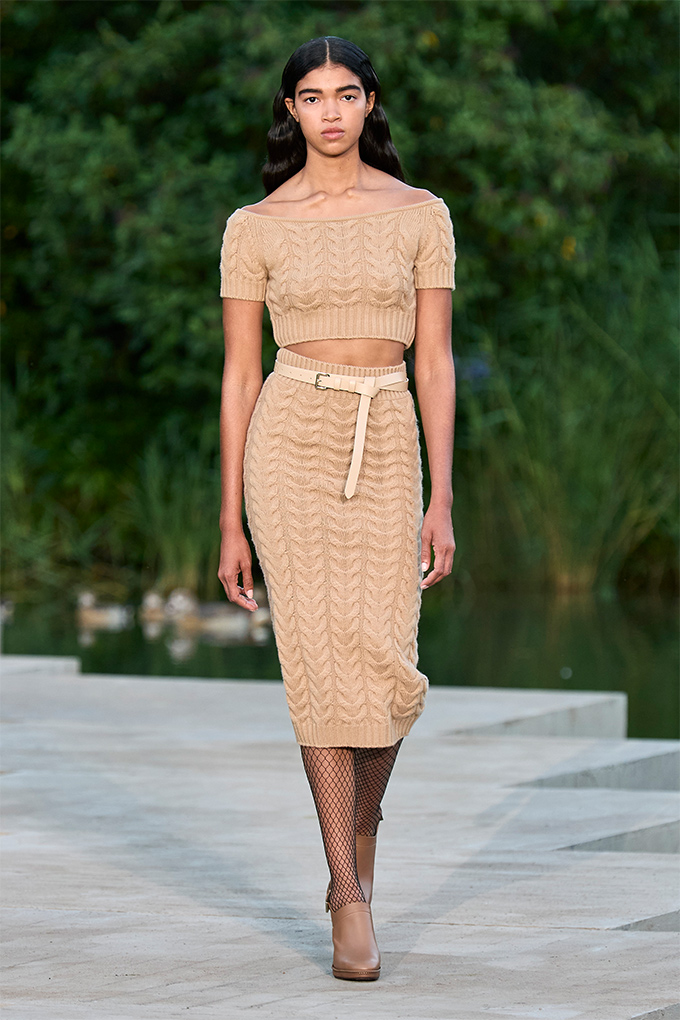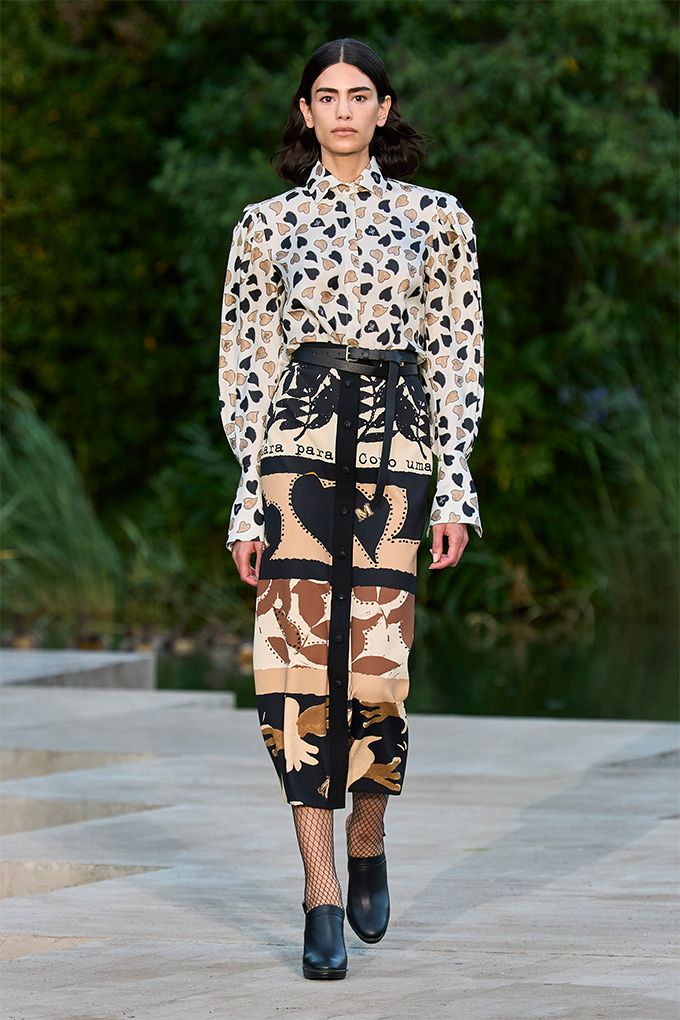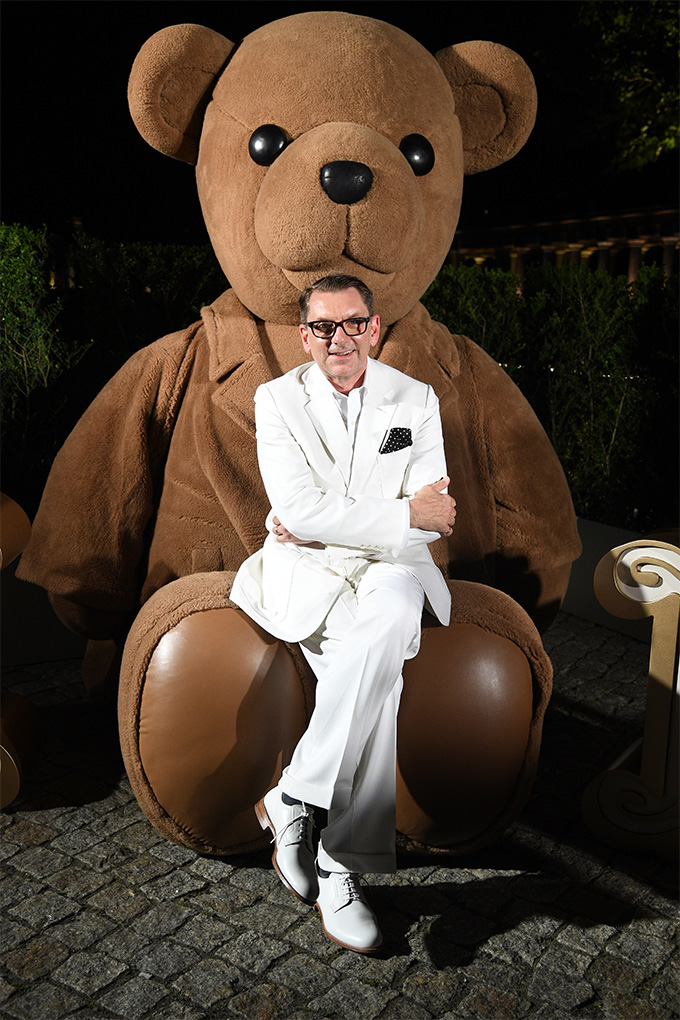Max Mara’s cruise 2023 collection was an ode to Lisbon—the capital of Portugal—tapping into the city’s culture and tradition whilst reimagining its own identity. The house’s creative director, Ian Griffiths, was touring the iconic Lisbon Calouste Gulbenkian museum last year when he chanced upon a portrait of the poet and activist Natália Correia, a largely faded name, who in the mid-20th century was at the center of Lisbon society. Known for her thought-provoking poetry and founding of Bar botequim—an intellectual salon and watering hole—Correia rose to popularity as a representative figure for femininity and liberalism. Her controversial yet prominent works inspired Griffiths, as he looked to her as his muse and starting point for this collection.
Befittingly, the show was held at the Gulbenkian museum and was split into several parts. The first section was a classic throwback—rooted in the house codes of Max Mara—with teddy coats, timeless tailoring, and several elegant evening looks. The garments were homogenised by the brand’s core identity, but attuned to the context of the collection. Then came an array of bold and vibrant looks, each heavily-patterned with striking visuals drawn by artisans. Long ribbed skirts with matching knitwear tops graced the runway, followed by floor-length dresses in blocks of warm shades. Silk tops in unique shapes were cinched at the waist, providing the wearer with a strong, confident silhouette. To top it all off, a male model walked the show, the first time in the house’s runway history.





This noteworthy moment was not the first time Griffiths has challenged the norm. Over his 35-year career at the helm of Max Mara, the British fashion designer has kept the Italian luxury label at the forefront of womenswear, staying culturally and politically relevant. The label’s unique approach to themes has been seen on multiple occasions, proving to be a signature approach of Griffiths’s.
Below, Vogue Singapore chats with the designer ahead of the show, discussing the inspiration behind the collection and some of his favourite looks.
Could you take us through how the painting of Portuguese icon Natália Correia became your primary source of inspiration for this collection?
I was looking for a woman, I was looking for a muse. It got me thinking about the turbulent, mid-century Portuguese landscape. Politically and culturally, it was a time of revolution and great unrest and turmoil. Since I was showing at the Gulbenkian, I went through the Gulbenkian collections in search of references. Looking through the contemporary collection, I found this picture of a woman with a really regal attitude. I discovered that her name was Natália Correia. It was a gift, to find a woman who was a major force in Portuguese history and culture, and whose impact is still felt, even though she was never well-known outside Portugal.

Talking about her as a person, how did you translate her ideals and spirit into your collection?
The salient thing about Natália was her political views as well as her brand of feminism, which was very erotically charged. I mean, she, she believed in erotic liberalism. There was a very strong sexual side to her. That got me thinking, how would that translate onto the clothes? There was a form of intellect to her sex appeal, a sense of femininity. It was a lesser known side of the Max Mara identity, so I wanted to highlight that within this collection.
You talked about sheath dresses and bustier gowns. Were there any other kind of design elements that exuded sexiness from that time?
There’s a new proportion where the tops are cut just three or four centimetres short of the waist so that you just get a sliver of flesh showing around the middle. Commercially, we’ve made it such that our tops and sweaters allow for folding of the garment, which shows off the midriff. I am aware that not everybody feels that they want to show that four centimetres of flesh all the time—there are days when you do and days when you don’t—so I’m always conscious we have to allow for that too.
“Looking through the contemporary collection, I found this picture of a woman with a really regal attitude. I discovered that her name was Natália Correia.”
You mentioned Natália and her friends were definitely the cultural cognoscenti of their time. One of her friends was the queen of fado music. How has fado music, if at all, been interpreted or used in the show?
Fado music is part of the project. You can’t really talk about Portugal without talking about fado. And my understanding of fado and saudade, which is the Portuguese word that means hope, longing, loss and nostalgia all mixed together, is understanding Carminho, who is the contemporary queen of fado. She has been a real friend throughout the whole process, and has tried on the whole collection. The whole soundtrack for the show is a remix of her work by Johnny Dynell, who’s this New York DJ that I’ve been working with for 15 or 20 years.
Why have you titled this collection vai lenco feliz?
Vai lenco feliz? Lenco is the name for the handkerchief. Feliz means happy, fortunate and lucky. So it means ‘go lucky handkerchief’, depicting an unmarried single woman dropping an embroided hankercheif in hopes it would make its way to a suitor.
“I want our customers to feel empowered. That puts all my words about sexiness in perspective. Max Mara clothes allow a woman to empower herself.”
What do you want your customers to feel when they’re wearing this collection?
I want our customers to feel empowered. That puts all my words about sexiness in perspective. Max Mara clothes allow a woman to empower herself. So whilst I wanted them in a way that is a bit more sexy, they’re not cut in a way that makes you feel self-conscious.
Are there any key looks that serve as a good visual representation of what you’re trying to say?
On the one hand, a new version of the teddy bear coat, which is inspired by images of Amália Rodriguez wearing a little mink coat in the 1970’s. I wanted to give that kind of feminine feeling to a teddy bear coat. Another key look would be one of the dresses that we are showing in the second half of the show with a very dramatic bustier dress and a plissé soleil construction. It consumes metres and metres and metres of fabric and is pleated in sections so that the pleats open as they drop to the hem, which in turn forms a chevron motif. It’s a slightly new departure for us—dresses that you can wear on red carpet occasions or even in the summer with a simple pair of black shoes.





